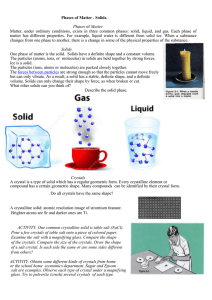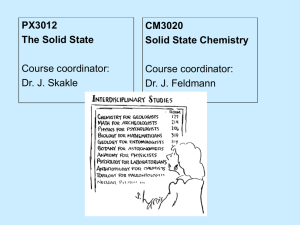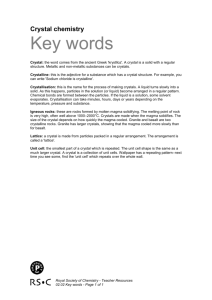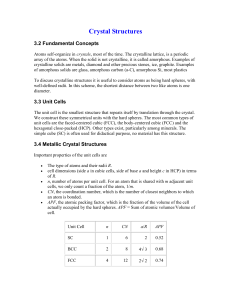INSPIRE GK12 Lesson Plan Molecular Geometry and Crystals 90 minutes
advertisement
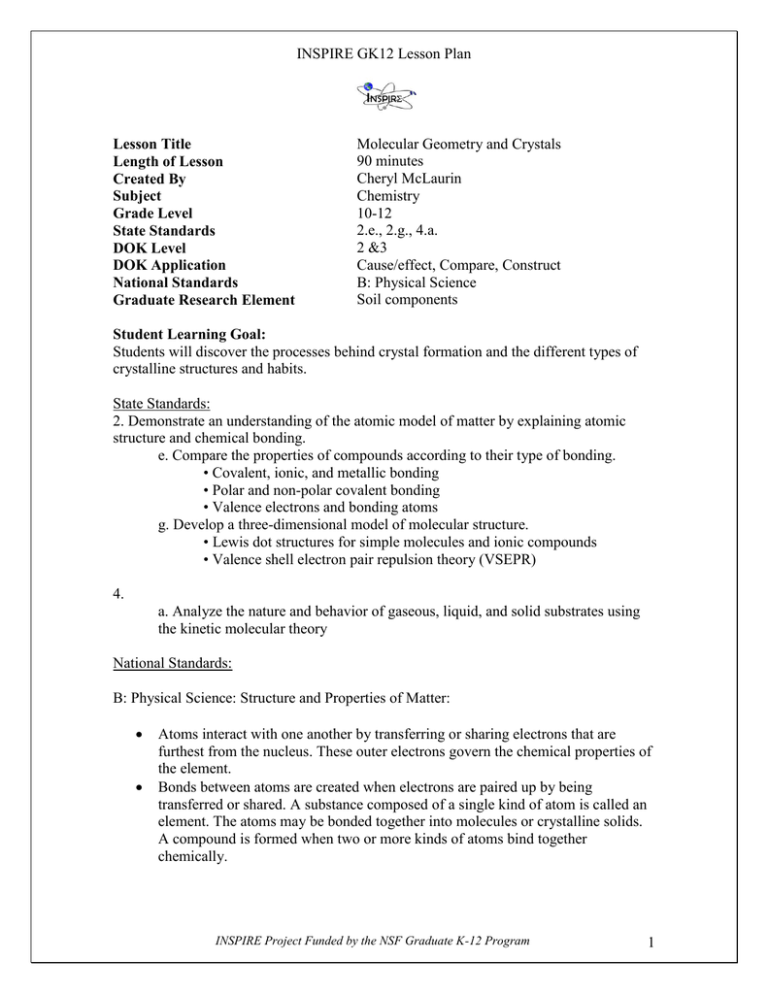
INSPIRE GK12 Lesson Plan Lesson Title Length of Lesson Created By Subject Grade Level State Standards DOK Level DOK Application National Standards Graduate Research Element Molecular Geometry and Crystals 90 minutes Cheryl McLaurin Chemistry 10-12 2.e., 2.g., 4.a. 2 &3 Cause/effect, Compare, Construct B: Physical Science Soil components Student Learning Goal: Students will discover the processes behind crystal formation and the different types of crystalline structures and habits. State Standards: 2. Demonstrate an understanding of the atomic model of matter by explaining atomic structure and chemical bonding. e. Compare the properties of compounds according to their type of bonding. • Covalent, ionic, and metallic bonding • Polar and non-polar covalent bonding • Valence electrons and bonding atoms g. Develop a three-dimensional model of molecular structure. • Lewis dot structures for simple molecules and ionic compounds • Valence shell electron pair repulsion theory (VSEPR) 4. a. Analyze the nature and behavior of gaseous, liquid, and solid substrates using the kinetic molecular theory National Standards: B: Physical Science: Structure and Properties of Matter: Atoms interact with one another by transferring or sharing electrons that are furthest from the nucleus. These outer electrons govern the chemical properties of the element. Bonds between atoms are created when electrons are paired up by being transferred or shared. A substance composed of a single kind of atom is called an element. The atoms may be bonded together into molecules or crystalline solids. A compound is formed when two or more kinds of atoms bind together chemically. INSPIRE Project Funded by the NSF Graduate K-12 Program 1 INSPIRE GK12 Lesson Plan The physical properties of compounds reflect the nature of the interactions among its molecules. These interactions are determined by the structure of the molecule, including the constituent atoms and the distances and angles between them. Materials Needed (supplies, hand-outs, resources): Powerpoint, Proscope, rock and mineral samples Lesson Performance Task/Assessment: Students will be asked to guess crystalline structure from mineral samples in class and crystalline structure will be covered on the unit exam. Lesson Relevance to Performance Task and Students: Recall and application of the lecture. Anticipatory Set/Capture Interest: Show examples of crystals encountered everyday (such as ice, salt, and sucrose) and see if students can identify what the images are Guided Practice: Students will receive a lecture on bond types and geometry and how they affect crystalline structure. They will be shown models of the different types of crystalline structure. The difference between crystalline structure and growth habit will be discussed. Real-world examples of crystals will be examined under the Proscope. Independent Practice: Students will evaluate crystals that are passed around the class. Remediation and/or Enrichment: IEP’s will be supported. Students can work hands-on with drawing models of crystal structure if they need more practice. For enrichment, examples of more complex crystals can be shown and described. Check(s) for Understanding: - What is the difference between crystal structure and habit? - What are the different types of crystal structure? - What effect does bond type have on crystal structure? Closure: Students will discuss where crystals not previously mentioned are encountered. Possible Alternate Subject Integrations: Earth Science INSPIRE Project Funded by the NSF Graduate K-12 Program 2 INSPIRE GK12 Lesson Plan Teacher Notes: - Make sure that students understand that rocks do not equal crystals. Examples of crystals can be found within certain rocks, but the whole rock is not a crystal. -Proscope link: http://www.bodelin.com/proscopehr/ INSPIRE Project Funded by the NSF Graduate K-12 Program 3



